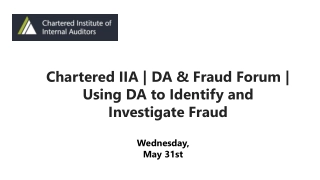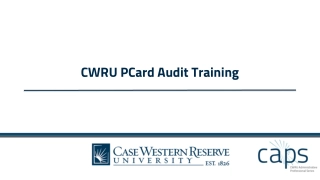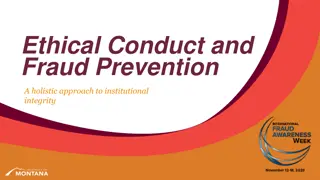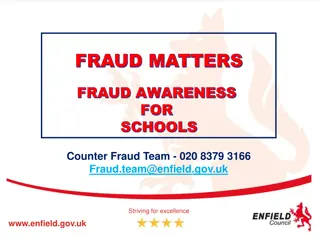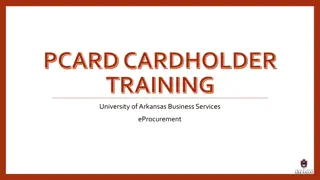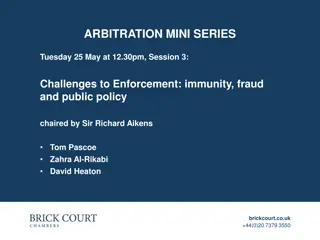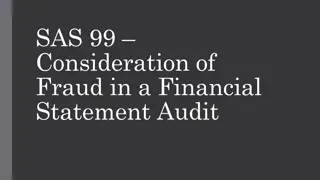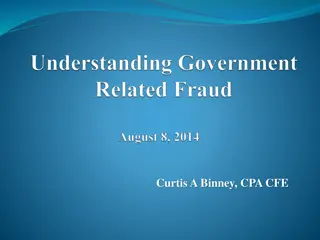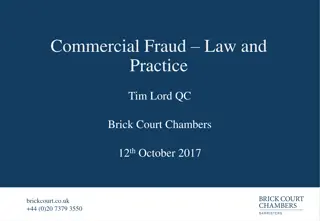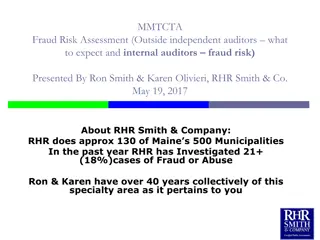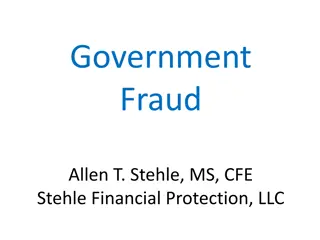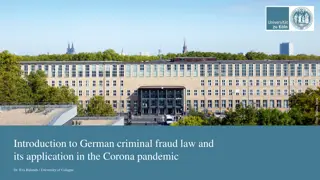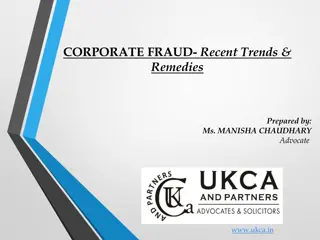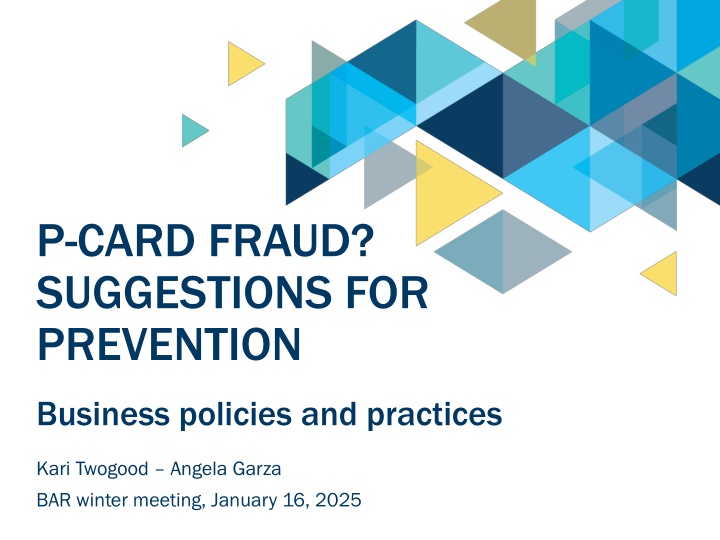
Preventing P-Card Fraud: Effective Strategies and Best Practices
"Discover key elements for preventing P-Card fraud, including clear policies, cardholder training, access controls, and separation of duties. Learn how to establish secure procedures, monitor transactions, and conduct thorough investigations to safeguard against fraudulent activities."
Download Presentation

Please find below an Image/Link to download the presentation.
The content on the website is provided AS IS for your information and personal use only. It may not be sold, licensed, or shared on other websites without obtaining consent from the author. If you encounter any issues during the download, it is possible that the publisher has removed the file from their server.
You are allowed to download the files provided on this website for personal or commercial use, subject to the condition that they are used lawfully. All files are the property of their respective owners.
The content on the website is provided AS IS for your information and personal use only. It may not be sold, licensed, or shared on other websites without obtaining consent from the author.
E N D
Presentation Transcript
P-CARD FRAUD? SUGGESTIONS FOR PREVENTION Business policies and practices Kari Twogood Angela Garza BAR winter meeting, January 16, 2025
A procurement card fraud prevention program involves a set of policies and procedures designed to minimize the risk of fraudulent transactions made using procurement cards (also known as P-cards) by implementing strict controls on card usage, regular monitoring of transactions, thorough employee training, and clear guidelines regarding appropriate purchases, all while maintaining a system for reporting and investigating suspicious activity. 2
KEY ELEMENTS Clear policies and procedures Cardhold training and awareness Access controls and separation of duties Transaction monitoring and analysis Spend limits and approvals Reporting and investigation Auditing and compliance 3
CLEAR POLICIES AND PROCEDURES Define eligible purchase categories and spending limits for each cardholder. Establish guidelines for proper receipt documentation and expense reporting. Specify procedures for reporting lost or stolen cards. Specify consequences for violating policy rules. Outline disciplinary actions for misuse of cards. 4
CARDHOLDER TRAINING AND AWARENESS Regular training sessions for all cardholders on proper card usage, fraud detection, and reporting procedures. Emphasize the importance of safeguarding card information and not sharing it with unauthorized individuals. Canvas Course: FIN: PU103 Purchasing (P-Card) Onboarding Training Materials 5
ACCESS CONTROLS AND SEPARATION OF DUTIES Limit the number of individuals with access to each procurement card. Assign a designated card custodian within departments responsible for managing and monitoring card usage. Separate responsibilities for approving purchases from those making them. Add a reviewer to the card holder profile that is not within same department 6
PS: CARD HOLDER PROFILE QRG: Card Holder Profile Adding a New P-Card Proxies: Proxy security roles must be set prior to assigning Each EMPLID can have only one proxy role on card 7
PS PROXY ROLES CC_ADMINISTRATOR CC_APPROVER CC_RECONCILER CC_REVIEWER CC_USER_REQ CC_USER_PO Procurement Card Access Rights document 8
TRANSACTION MONITORING AND ANALYSIS Regular review of transaction statements to identify suspicious activity like unusual spending patterns, large purchases, or transactions at inappropriate merchants. Utilize data analytics tools to identify potential fraud indicators based on historical spending trends. QRG: Reconciling P-Card Transactions 9
SPEND LIMITS AND APPROVALS Set appropriate spending limits based on the cardholder's role and department. Implement a system for mandatory approvals on transactions exceeding designated thresholds. 10
REPORTING AND INVESTIGATION Establish a clear process for employees to report suspected fraudulent activity. Promptly investigate all reported incidents of potential fraud. 12
AUDITING AND COMPLIANCE Regular internal audits of the procurement card program to assess compliance with policies and identify areas for improvement. Periodic review of cardholder compliance with established guidelines. 13
TRANSACTION AUDITS Who, How, When Transaction audits: Could be conducted by the P- Card program administrator or manager (PA/PM), an internal audit department or other department (Reviewer Proxy) Should occur a minimum of monthly What to Avoid Manually auditing all P-Card transactions every month, which is tedious and costly; Exclusively conducting random, percentage-based audits (e.g., 10% of transactions), which can result in some cardholders slipping through the cracks 14
STRATEGIC P-CARD AUDITS Your strategy should include auditing transactions that have certain attributes, such as those: at or above a certain dollar threshold with certain merchant category codes (MCCs) and/or suppliers (e.g., Amazon) containing key words that could indicate a prohibited purchase per your policies and procedures occurring during non-business hours 15
STRATEGIC P-CARD AUDITS, CONT. Look for suppliers used by only one cardholder; this might indicate an issue or something fishy. In addition, audit all transactions by certain cardholders, such as those who: are new to the cardholder role have a new manager/approver exceed a certain number of transactions during the month *These are just some examples* Do not exclude executive cardholders just because of their job level. 16
IMPORTANT CONSIDERATIONS Utilize procurement card system that provides real- time transaction monitoring. Promote a culture of accountability and ethical behavior within the organization regarding procurement card usage. Regularly assess the effectiveness of the fraud prevention program and make adjustments as needed based on emerging risks and trends. 17
P-Card program: Audit and Risk Assessment Angela Garza, Angela Garza, Yakima Yakima 18
THANK YOU Except where otherwise noted, this work is licensed under CC BY 4.0.

